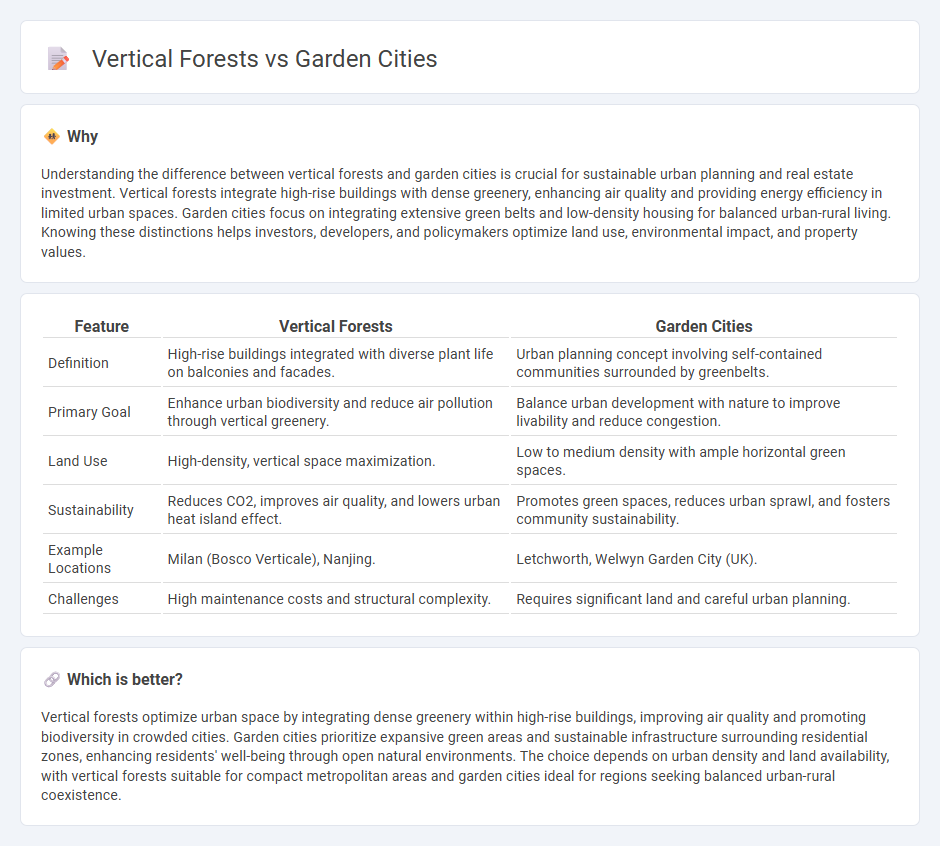
Vertical forests enhance urban sustainability by integrating dense vegetation within high-rise buildings, improving air quality and biodiversity in limited spaces. Garden cities focus on balanced urban planning that merges residential areas with extensive green spaces to promote healthier living environments and reduce pollution. Explore how these innovative real estate concepts reshape modern city landscapes for a greener future.
Why it is important
Understanding the difference between vertical forests and garden cities is crucial for sustainable urban planning and real estate investment. Vertical forests integrate high-rise buildings with dense greenery, enhancing air quality and providing energy efficiency in limited urban spaces. Garden cities focus on integrating extensive green belts and low-density housing for balanced urban-rural living. Knowing these distinctions helps investors, developers, and policymakers optimize land use, environmental impact, and property values.
Comparison Table
| Feature | Vertical Forests | Garden Cities |
|---|---|---|
| Definition | High-rise buildings integrated with diverse plant life on balconies and facades. | Urban planning concept involving self-contained communities surrounded by greenbelts. |
| Primary Goal | Enhance urban biodiversity and reduce air pollution through vertical greenery. | Balance urban development with nature to improve livability and reduce congestion. |
| Land Use | High-density, vertical space maximization. | Low to medium density with ample horizontal green spaces. |
| Sustainability | Reduces CO2, improves air quality, and lowers urban heat island effect. | Promotes green spaces, reduces urban sprawl, and fosters community sustainability. |
| Example Locations | Milan (Bosco Verticale), Nanjing. | Letchworth, Welwyn Garden City (UK). |
| Challenges | High maintenance costs and structural complexity. | Requires significant land and careful urban planning. |
Which is better?
Vertical forests optimize urban space by integrating dense greenery within high-rise buildings, improving air quality and promoting biodiversity in crowded cities. Garden cities prioritize expansive green areas and sustainable infrastructure surrounding residential zones, enhancing residents' well-being through open natural environments. The choice depends on urban density and land availability, with vertical forests suitable for compact metropolitan areas and garden cities ideal for regions seeking balanced urban-rural coexistence.
Connection
Vertical forests and garden cities both emphasize integrating extensive greenery into urban environments to enhance air quality and promote biodiversity. Vertical forests use high-rise buildings covered with trees and plants to create micro-ecosystems, while garden cities incorporate large green spaces, parks, and sustainable infrastructure at a city-wide scale. Both concepts aim to reduce urban heat islands and improve residents' well-being through green urban planning and sustainable development.
Key Terms
Urban Planning
Garden cities emphasize low-density development, integrating extensive green spaces and self-contained communities to balance urban and rural benefits. Vertical forests prioritize high-density urban living with residential skyscrapers featuring integrated vegetation, enhancing air quality and biodiversity within limited urban footprints. Explore detailed comparisons to understand the future of sustainable urban planning.
Green Infrastructure
Garden cities integrate expansive green infrastructure through parks, tree-lined streets, and urban agriculture, promoting biodiversity and sustainable urban living. Vertical forests employ dense vegetation on building facades and balconies, enhancing air quality, reducing heat islands, and maximizing green space in vertical urban environments. Explore the advantages and challenges of garden cities and vertical forests to understand their impact on future sustainable urban planning.
Sustainable Development
Garden cities prioritize green open spaces and urban agriculture to enhance biodiversity and reduce urban heat islands, aligning with sustainable development goals (SDGs) on climate action and sustainable communities. Vertical forests integrate trees and shrubs into high-rise buildings, improving air quality, capturing CO2, and promoting energy efficiency through natural insulation, directly supporting SDGs on clean energy and sustainable urbanization. Explore the innovative strategies and environmental benefits of these models to foster sustainable urban growth.
Source and External Links
Garden City Movement - The garden city movement is a 20th-century urban planning approach promoting satellite communities with greenbelts, residences, industry, and agriculture, initiated by Ebenezer Howard in 1898.
List of Garden Cities - This list includes various cities worldwide that have been developed as or influenced by the garden city movement, featuring examples from several continents.
What Are Garden Cities? - Garden cities are planned communities that combine the benefits of urban and rural environments, aiming to address issues of urban growth and rural isolation through progressive urban planning.
 dowidth.com
dowidth.com